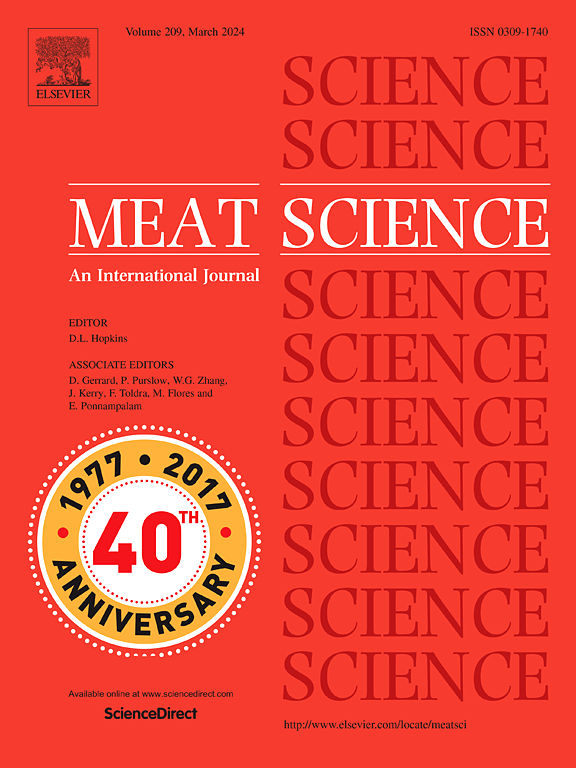三维成像在农场估计活牛的性状和胴体重量预测
IF 7.1
1区 农林科学
Q1 Agricultural and Biological Sciences
引用次数: 0
摘要
本研究展示了一个以处理速度运行的三维(3D)成像系统,该系统部署在一个商业饲养场,可根据单个活牛的形状评估臀高(cm)、P8部位皮下脂肪厚度(mm)和热标准胴体重(HSCW, kg)。一项分为两部分的研究进行了:研究1评估了247名受试者的臀高(cm)和219名受试者的超声扫描P8脂肪(mm)与3D图像投影的对比;研究2评估了屠宰场32头安格斯牛的HSCW与3D图像的预测。臀部高度直接从3D图像中估计,而P8脂肪和HSCW使用基于高斯过程监督学习从这些图像中提取的特征的模型进行预测。采用交叉验证对模型进行评估。测量的髋关节高度与3D成像的实时估计值的RMSE = 3.07 cm, R2 = 0.69。超声扫描的P8脂肪与3D成像的实时预测结果RMSE = 2.38 mm, R2 = 0.78;屠宰场HSCW与3D成像实时预测的RMSE = 8.15 kg, R2 = 0.79。3D成像系统的设计,具有多个摄像头,安装在传统的比赛中,用于处理牛,并有效地处理牛的长度和品种。该3D成像系统证明了牛肉行业采用该系统的可行性,通过将3D成像和BeefSpecs集成到一种名为“牛评估3D”的技术中来创造价值。本文章由计算机程序翻译,如有差异,请以英文原文为准。
3D imaging for on-farm estimation of live cattle traits and carcass weight prediction
This study presents a 3-dimensional (3D) imaging system, operating at processing speed, deployed at a commercial feedlot, that assesses hip height (cm), subcutaneous fat thickness at the P8 site (mm), and hot standard carcass weight (HSCW, kg) from the shape of individual live cattle. A two-part study was conducted: Study 1 evaluated measured hip height (cm) on 247 steers and ultrasound scanned P8 fat (mm) on 219 steers versus projections from 3D images; and Study 2 evaluated abattoir HSCW on 32 Angus steers versus predictions from 3D images. Hip height was directly estimated from the 3D images, while P8 fat and HSCW were predicted using a model based on features extracted from these images through supervised learning with Gaussian Processes. The models were evaluated using cross-validation. The measured hip height versus live estimates from 3D imaging resulted in a RMSE = 3.07 cm, and R2 = 0.69. The ultrasound scanned P8 fat versus live predictions from 3D imaging resulted in a RMSE = 2.38 mm, and R2 = 0.78; and the abattoir HSCW versus live predictions from 3D imaging resulted in a RMSE = 8.15 kg, and R2 = 0.79. The design of the 3D imaging system, with multiple cameras, was installed into a traditional race for processing cattle and effectively operates with variation in length and breeds of cattle. The 3D imaging system demonstrates the feasibility of adoption by the beef industry that creates value through the integration of 3D imaging and BeefSpecs into a technology called CattleAssess3D.
求助全文
通过发布文献求助,成功后即可免费获取论文全文。
去求助
来源期刊

Meat Science
工程技术-食品科技
CiteScore
12.60
自引率
9.90%
发文量
282
审稿时长
60 days
期刊介绍:
The aim of Meat Science is to serve as a suitable platform for the dissemination of interdisciplinary and international knowledge on all factors influencing the properties of meat. While the journal primarily focuses on the flesh of mammals, contributions related to poultry will be considered if they enhance the overall understanding of the relationship between muscle nature and meat quality post mortem. Additionally, papers on large birds (e.g., emus, ostriches) as well as wild-captured mammals and crocodiles will be welcomed.
 求助内容:
求助内容: 应助结果提醒方式:
应助结果提醒方式:


